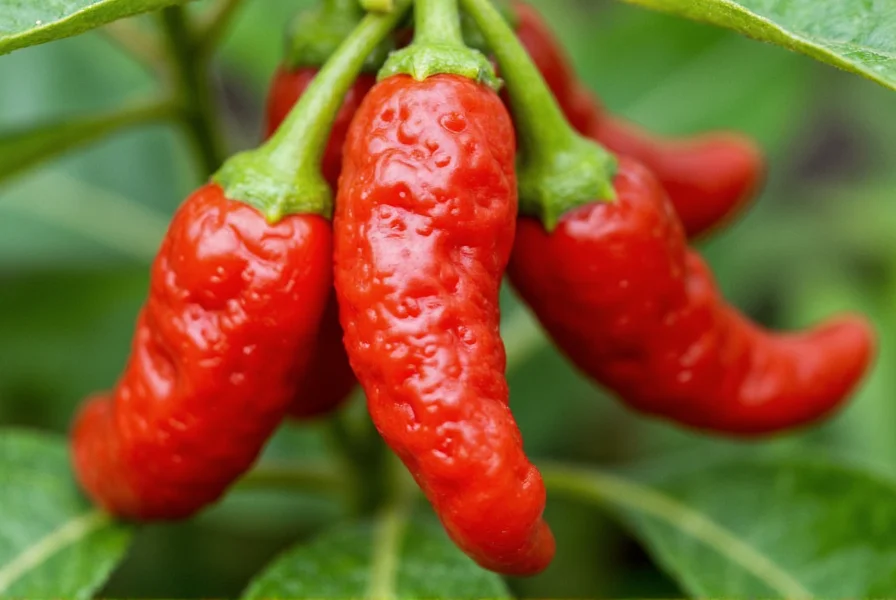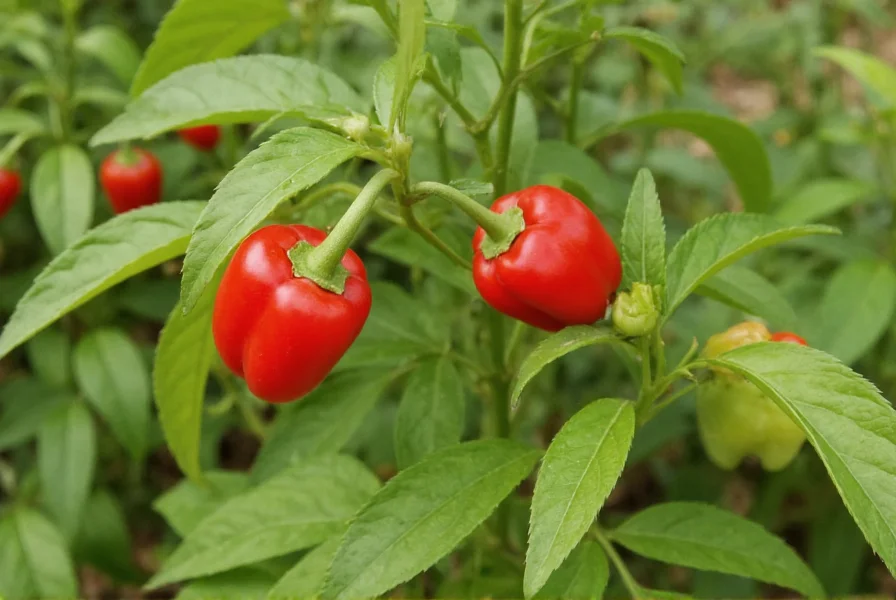The Carolina Reaper represents the pinnacle of cultivated chili pepper heat, offering both culinary challenges and opportunities for heat enthusiasts. Understanding this extreme pepper requires examining its origins, characteristics, and proper handling techniques to safely enjoy its unique flavor profile beyond just intense heat.
Understanding Carolina Pepper Varieties
While "Carolina pepper" commonly refers to the Carolina Reaper, it's important to distinguish between related superhot varieties:
| Pepper Variety | Scoville Heat Units | Origin | Distinctive Features |
|---|---|---|---|
| Carolina Reaper | 1,400,000-2,200,000 SHU | South Carolina, USA | Bumpy texture, red color, sweet undertones |
| Trinidad Moruga Scorpion | 1,200,000-2,000,000 SHU | Trinidad and Tobago | Stinger tail, fruitier flavor |
| Ghost Pepper (Bhut Jolokia) | 800,000-1,041,427 SHU | India | Smoky flavor, wrinkled appearance |
| 7 Pot Douglah | 923,889-1,853,936 SHU | Trinidad | Chocolate brown color, complex flavor |
The Science Behind Carolina Reaper's Intense Heat
Carolina Reaper's extreme heat comes from exceptionally high capsaicinoid concentrations, particularly capsaicin and dihydrocapsaicin. These compounds trigger TRPV1 receptors in the mouth and skin, creating the burning sensation we perceive as "heat." Unlike many superhots that deliver immediate heat, Carolina Reaper features a delayed onset followed by prolonged intensity that can last 20-45 minutes.
What makes Carolina Reaper unique among superhot peppers is its complex flavor profile. Despite its extreme heat rating, it offers distinct fruity and slightly sweet undertones that many chili enthusiasts appreciate. This dual characteristic of intense heat with discernible flavor makes it valuable for specialty hot sauces where both heat and taste matter.

Growing Carolina Peppers Successfully
Cultivating Carolina Reaper peppers requires specific conditions to thrive. These plants need 90-120 days to reach maturity and prefer warm temperatures between 70-90°F (21-32°C). Successful growers of Carolina Reaper peppers recommend:
- Starting seeds indoors 8-10 weeks before last frost
- Using well-draining soil with pH 6.0-7.0
- Providing 6-8 hours of direct sunlight daily
- Maintaining consistent moisture without waterlogging
- Using balanced fertilizer during flowering and fruiting stages
One challenge specific to growing Carolina Reaper peppers is their sensitivity to temperature fluctuations. Unlike some hardier pepper varieties, Carolina Reapers require stable warm conditions throughout their growing season. Many home gardeners growing Carolina Reaper peppers achieve best results in containers that can be moved indoors during cooler nights.
Safety Considerations for Handling Superhot Peppers
Working with Carolina Reaper peppers demands proper safety precautions due to their extreme capsaicin concentration. Essential safety measures include:
- Wearing nitrile gloves (latex won't protect against capsaicin)
- Avoiding contact with eyes, face, or sensitive skin
- Working in well-ventilated areas to prevent inhalation of capsaicin particles
- Washing hands thoroughly with soapy water after handling
- Using separate cutting boards and utensils for superhot peppers
If you accidentally get Carolina Reaper oil on your skin, wash immediately with dish soap and cool water. For eye exposure, flush with saline solution or artificial tears. Milk or yogurt can help alleviate mouth burn if you consume too much, as the casein protein binds to capsaicin molecules.
Culinary Applications of Carolina Pepper
Despite its fearsome reputation, Carolina Reaper offers culinary versatility when used appropriately. Professional chefs working with Carolina Reaper peppers typically:
- Use tiny amounts (1/16 to 1/8 teaspoon of minced pepper) per serving
- Remove seeds and membranes where most capsaicin concentrates
- Pair with complementary flavors like mango, pineapple, or citrus
- Create infused oils or vinegars for controlled heat application
- Make small-batch hot sauces for specialty products
One popular technique among hot sauce makers using Carolina Reaper peppers involves roasting the peppers first to develop deeper, smokier flavors while slightly reducing raw heat intensity. The resulting sauces often showcase the pepper's underlying fruitiness rather than just overwhelming heat.

Health Benefits and Considerations
Like other chili peppers, Carolina Reaper contains capsaicin which offers potential health benefits when consumed in appropriate amounts. Research on capsaicin benefits includes:
- Potential metabolism boost and weight management support
- Natural pain relief properties through endorphin release
- Rich in vitamins A and C (though heat limits consumption quantity)
- Possible anti-inflammatory effects
However, individuals with gastrointestinal conditions should exercise extreme caution with Carolina Reaper consumption. The intense heat can trigger severe discomfort for those with ulcers, IBS, or other digestive sensitivities. Moderation remains essential when incorporating Carolina Reaper into your diet.
Frequently Asked Questions About Carolina Pepper
How hot is the Carolina Reaper compared to other peppers?
The Carolina Reaper measures between 1,400,000-2,200,000 Scoville Heat Units (SHU), making it approximately 275 times hotter than a jalapeño (5,000-8,000 SHU) and about twice as hot as a habanero (100,000-350,000 SHU). It's consistently ranked among the top 3 hottest peppers in the world.
Can you eat a whole Carolina Reaper pepper?
While technically possible, eating a whole Carolina Reaper is not recommended for most people. The extreme capsaicin concentration can cause severe gastrointestinal distress, temporary breathing difficulties, and intense pain. Competitive eaters typically consume only small portions, and even experienced chili enthusiasts use Carolina Reaper in minute quantities for cooking.
How do you grow Carolina Reaper peppers successfully?
Carolina Reaper peppers require 90-120 days of warm weather (70-90°F), well-draining soil with pH 6.0-7.0, and consistent moisture. Start seeds indoors 8-10 weeks before last frost, provide 6-8 hours of direct sunlight daily, and maintain stable temperatures. These peppers are more sensitive to temperature fluctuations than other varieties, so container growing with indoor protection during cool nights often yields best results.
What's the difference between Carolina Reaper and other superhot peppers?
Carolina Reaper differs from other superhots through its distinctive bumpy texture, slightly sweet undertones beneath extreme heat, and characteristic 'stinger' at the bottom. Compared to Ghost Peppers (800,000-1,041,427 SHU), Carolina Reaper is significantly hotter. Unlike Trinidad Moruga Scorpion's fruitier profile, Carolina Reaper offers more balanced sweet-heat complexity, making it preferred by many hot sauce makers for its flavor dimension beyond pure heat.
How should you handle Carolina Reaper peppers safely?
Always wear nitrile gloves (not latex) when handling Carolina Reaper peppers, work in a well-ventilated area, and avoid touching your face. Use separate cutting boards and utensils dedicated to superhot peppers. After handling, wash hands thoroughly with soap and cool water. Consider wearing safety glasses to protect eyes from airborne capsaicin particles, especially when cutting or processing large quantities.











 浙公网安备
33010002000092号
浙公网安备
33010002000092号 浙B2-20120091-4
浙B2-20120091-4